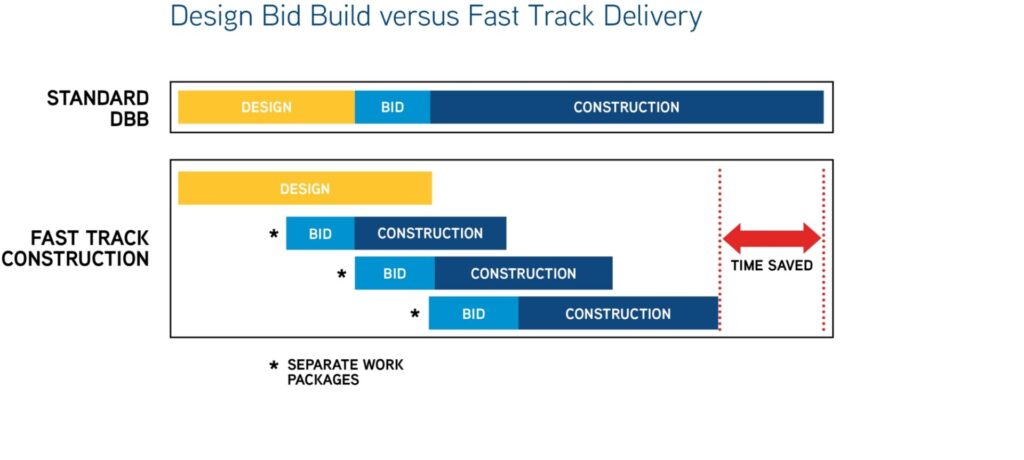The parameters of construction have changed drastically over the past few years, and it’s only natural that these changes have been reflected in how the work is completed. Technological advancements provide industry professionals with the tools to boost efficiency and, as a result, have helped to speed construction using innovative approaches.
The effects of the pandemic highlight the significance of maintaining economic stimulation as a top priority. It is crucial to employ innovative measures to execute and recover your capital projects. Under pressurized conditions, fast tracking can reorient a project, ensuring its efficient and timely delivery within budgetary constraints.
How does fast-tracking work?
Fast tracking is a construction methodology that can help shorten the overall project schedule. It works by overlapping a project’s programming, procurement, design, and construction phases so that some of the work can be done concurrently rather than waiting for all design work to be done before construction begins.
Owners use fast tracking most often when their private or public sector projects have pre-determined or demanding timelines. Projects impacted by ongoing operations or those that have less flexibility due to service requirements – such as municipal, education and healthcare projects – can benefit from fast tracking as a way to speed construction and achieve delivery goals.
Fast tracking is most effective when it’s introduced at the beginning of a project. It’s designed to help you and your consultants develop design and procurement packages in a way that offers optimal benefits to everyone involved – like completing projects in a shorter time frame. Fast tracking extends across multiple construction phases and demands strong coordination between the design and tendering packages to effectively implement its techniques.

Fast Tracking: Key Benefits and Strategies
Fast tracking your project offers several advantages – not only for you as an owner but also for consultants and contracting teams, including:
- Reducing project delivery times: By overlapping and taking a multi-phased approach to design and construction, construction teams can work concurrently to compress the overall project schedule. This in turn enables new facilities or spaces to open faster and begin operations sooner.
- Recovering at-risk projects with fast-tracking: Projects facing schedule delays are generally considered at risk. By implementing fast tracking techniques, projects can regain stability and make up for lost time due to delays.
- Mitigating supply chain delays: Given the current supply chain limitations, there are extended lead times for different pieces of equipment, making it essential to expedite user requirements, design tasks and contractor selection through fast tracking. This approach facilitates early procurement, helps to prevent delays and ensures equipment can be procured and installed on time.
- Keeping costs down with accelerated timelines: Inherent to a reduced delivery timeline is reduced project costs. Risks associated with cost escalation and general overheads are generally well contained in comparison to a project that has a longer delivery timeframe.
- Freeing up resources: Shorter project schedules and more efficient tools enable owners to complete the work in less time, thereby freeing up resources to take on new projects. When successfully applied, fast tracking enables owners, as well as consultant and contracting teams, to handle a higher volume of projects in a shorter time period, thereby making it possible to generate more revenue.
For example, consider you’re under a time constraint to develop a new distribution warehouse to meet higher demands for locally sourced products due to delayed permit approvals. By working with a project management team, you can develop an RFP that outlines a fast tracking schedule to complete the project in a much shorter time frame. By incorporating fast tracking in the planning and procurement stages, you can:
- Obtain all permits and approvals early to mitigate delays and speed up the overall schedule;
- Decrease the overall timeline of the project;
- Provide clear and detailed bid documents to the design consultant as to how the design will be developed and managed; and
- Provide clear and detailed tender documents to the contractor so construction can be managed alongside the design.
Design and construction tasks are carried out in parallel rather than sequentially, with careful coordination of each phase of design and construction development. By implementing this approach in the planning stages, the project can be delivered much earlier than if a more traditional Design-Bid-Build construction methodology was adopted, leaving you in a position to meet shipment demands.
Successful Strategies
As with any construction methodology, fast tracking must be executed properly. As an owner, you should be mindful to assign a project manager or project team experienced in fast-tracking techniques. By adjusting your RFP to include fast tracking requirements, the project team can plan for a phased distribution of the workload, mitigate risks and deliver the fast tracked project successfully.
Not only does fast tracking provide you with a way to deliver projects faster, it can help revive projects that have encountered delays. As the construction industry becomes more familiar with the methodology, project experts will have the experience and confidence to mitigate risks, expedite construction and uphold quality standards on your behalf.





